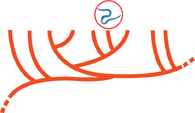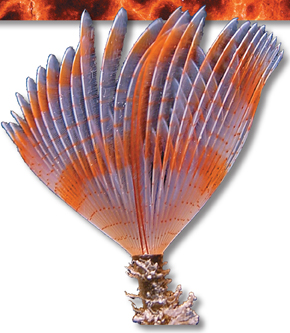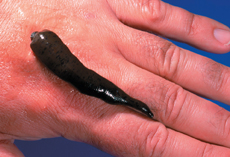Annelids (Segmented Worms)


Peacock worms, whose feather-shaped gills look somewhat like peacock feathers, are marine annelids, or polychaetes.
KEY CHARACTERISTICS
Annelids are coelomate protostome worms whose bodies are composed of segments separated by internal partitions. The annelid digestive system has two openings.
Feeding and Digestion Filter feeders, carnivores, or parasites; many obtain food using a muscular pharynx, often equipped with “teeth”; widely varied digestive systems—some, such as earthworms, have complex digestive tracts.
Circulation Closed circulatory system with dorsal and ventral blood vessels; dorsal vessel pumps blood like a heart.
Respiration Aquatic—gills; terrestrial—skin
Excretion Digestive waste exits through anus; nitrogenous wastes eliminated by nephridia
Response Nervous system includes a rudimentary brain and several nerve cords; sense organs best-developed in free-living saltwater species
Movement Hydrostatic skeleton based on sealed body segments surrounded by longitudinal and circular muscles; many annelids have appendages that enable movement.
Reproduction Most—sexual, some through external fertilization with separate sexes, but others are simultaneous hermaphrodites that exchange sperm; most have a trochophore larval stage
• Did You Know?
Not-So-Modern Medicine
You may have heard that medieval healers used leeches to remove “excess” blood from patients and to clean wounds after surgery. But did you know that leeches—or at least compounds from leech saliva—have a place in modern medicine? Leech saliva contains the protein hirudin, which prevents blood from clotting. Some surgeons use leeches to relieve pressure caused by blood that pools in tissues after plastic surgery. Hirudin is also used to prevent unwanted blood clots.

Leech ( Hirudo medicinalis) drawing blood from a hand
Table of Contents
- Formulas and Equations
- Applying Formulas and Equations
- Mean, Median, and Mode
- Estimation
- Using Measurements in Calculations
- Effects of Measurement Errors
- Accuracy
- Precision
- Comparing Accuracy and Precision
- Significant Figures
- Calculating With Significant Figures
- Scientific Notation
- Calculating With Scientific Notation
- Dimensional Analysis
- Applying Dimensional Analysis




